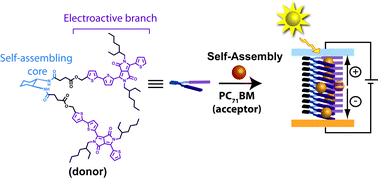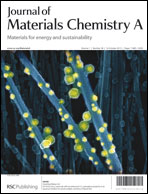Stepwise self-assembly to improve solar cell morphology†
Abstract
Organic photovoltaic device efficiencies can be greatly improved by controlling the morphology of donor and acceptor domains in the active layer. Connectivity within donor and acceptor domains is of key importance in order to direct charge carriers efficiently to the electrodes. We report here on self-assembly pathways leading towards optimal morphology of solar cell active layers, using as the donor a hairpin-shaped molecule containing a trans-1,2-diamidocyclohexane core and two arms of diketopyrrolopyrrole conjugated segments, and a C71 fullerene derivative as the electron acceptor. Self-assembly of the donor molecule is driven by the synergistic action of hydrogen bonds and π–π stacking, and under proper conditions this results in the formation of long supramolecular nanowires that enhance charge transport and device efficiencies. We found that a stepwise cooling process with minimal stirring of solutions is necessary to create by self-assembly robust wires that are not disrupted when acceptor molecules are added. The efficiencies of devices created by this process can be 400-fold greater than those of devices formed by simple mixing of donor and acceptor molecules. The synergistic action of hydrogen bonds and π stacking in donor molecules that create long nanowires by self-assembly results in devices that are 54% more efficient than those built with analogous donor molecules containing only the conjugated structure.


 Please wait while we load your content...
Please wait while we load your content...